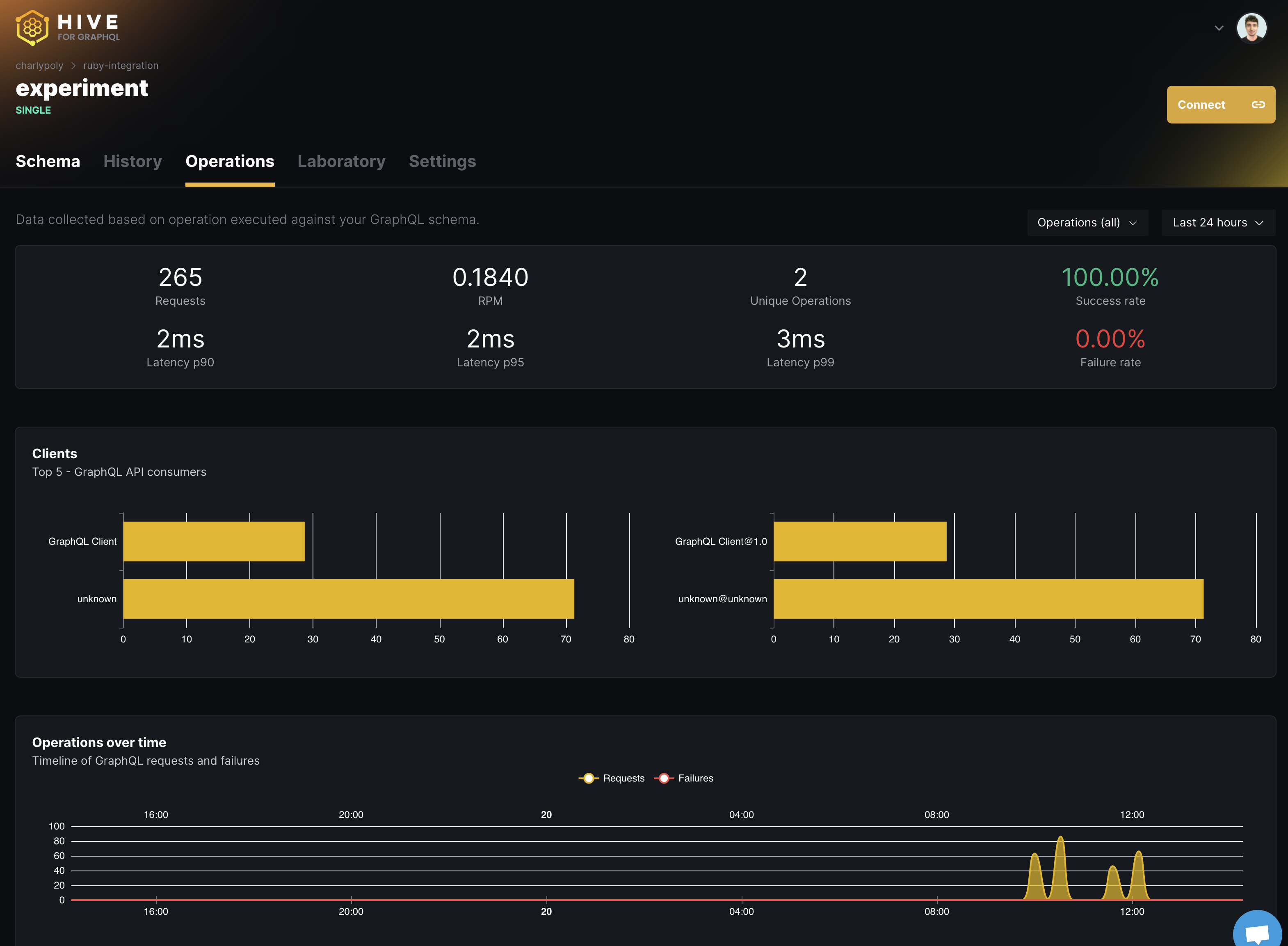GraphQL Hive provides all the tools to get visibility of your GraphQL architecture at all stages, from standalone APIs to composed schemas (Federation, Stitching):
- Schema Registry with custom breaking changes detection
- Monitoring of RPM, latency, error rate, and more
- Integrations with your favorite tools (Slack, Github Actions, and more)
If you are using Hive as a service, please refer to our documentation: https://docs.graphql-hive.com/features/tokens.
gem install graphql-hive
Add GraphQL::Hive at the end of your schema definition:
class Schema < GraphQL::Schema
query QueryType
use(
GraphQL::Hive,
{
token: '<YOUR_TOKEN>',
reporting: {
author: ENV['GITHUB_USER'],
commit: ENV['GITHUB_COMMIT']
},
}
)
endThe reporting configuration is required to push your GraphQL Schema to the Hive registry.
Doing so will help better detect breaking changes and more upcoming features.
If you only want to use the operations monitoring, replace the reporting option with the following report_schema: false.
Calling these hooks are situational - it's likely that you may not need to call them at all!
Call this hook if you are running GraphQL::Hive in a process that forks
itself.
example: puma web server running in ("clustered
mode")
# config/puma.rb
preload_app!
on_worker_boot do
GraphQL::Hive.instance.on_start
endIf your GraphQL API process is shut down non-gracefully but has a shutdown hook
to call into, call on_worker_exit.
puma example:
# config/puma.rb
on_worker_shutdown do
GraphQL::Hive.instance.on_exit
endYou are all set! 🚀
When deploying or starting up your GraphQL API, graphql-hive will immediately:
- publish the schema to the Hive registry
- forward the operations metrics to Hive
You should now see operations information (RPM, error rate, queries performed) on your GraphQL Hive dashboard:
Stay on top of your GraphQL Schema changes by installing the Hive Github Application and enabling Slack notifications about breaking changes:
https://docs.graphql-hive.com/features/integrations#github
You will find below the complete list of options of GraphQL::Hive:
class MySchema < GraphQL::Schema
use(
GraphQL::Hive,
{
# Token is the only required configuration value.
token: 'YOUR-REGISTRY-TOKEN',
#
# The following are optional configuration values.
#
# Enable/disable Hive Client.
enabled: true,
# Verbose logs.
debug: false,
# A custom logger.
logger: MyLogger.new,
# Endpoint and port of the Hive API. Change this if you are using a self-hosted Hive instance.
endpoint: 'app.graphql-hive.com',
port: 80,
# Number of operations sent to Hive in a batch (AFTER sampling).
buffer_size: 50,
# Size of the queue used to send operations to the buffer before sampling.
queue_size: 1000,
# Report usage to Hive.
collect_usage: true,
# Usage sampling configurations.
collect_usage_sampling: {
# % of operations recorded.
sample_rate: 0.5,
# Custom sampler to assign custom sampling rates.
sampler: proc { |context| context.operation_name.includes?('someQuery') 1 : 0.5 },
# Sample every distinct operation at least once.
at_least_once: true,
# Assign custom keys to distinguish between distinct operations.
key_generator: proc { |context| context.operation_name }
},
# Publish schema to Hive.
report_schema: true,
# Mandatory if `report_schema: true`.
reporting: {
# Mandatory members of `reporting`.
author: 'Author of the latest change',
commit: 'git sha or any identifier',
# Optional members of `reporting`.
service_name: '',
service_url: '',
},
# Pass an optional proc to client_info to help identify the client (ex: Apollo web app) that performed the query.
client_info: proc { |context|
{ name: context.client_name, version: context.client_version }
}
}
)
# ...
endSee default options for the optional parameters here.
Important
buffer_size and queue_size will affect memory consumption.
buffer_size is the number of operations sent to Hive in a batch after operations have been sampled.
queue_size is the size of the queue used to send operations to the buffer before sampling.
Adjust these values according to your application's memory constraints and throughput.
High throughput applications will need a larger queue_size.

